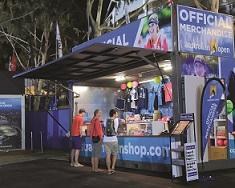

Mostly, what people walk away with these days is a T-shirt. Year after year, it remains the favorite souvenir, and that never changes. Even though it’s easy to say that athletes at all levels already have a lot of shirts and maybe even more than they can possibly wear, they’ll be happier with the shirt you give them than they would be if you didn’t offer anything.
T-shirts are the classic souvenir. Many times, people can wear them to participate in the event, or they can wear them home afterwards. They’re also a great marketing piece, doing advertising for your event year-round – because in theory, people can wear them everywhere, in all seasons. But will they? If you want to be sure people to wear your shirt long after the event is over, you need to follow their preferences as consumers. We as merchandise suppliers have learned a few things, and we’re glad to share them with you.
Fabric Options
A lot of sports events have been getting into the technical, or sweat-wicking, apparel. It can cost a bit more, but athletes will wear it when they’re working out, which means it’s great marketing for your event, particularly to other athletes at the gym or when running out on the road.
Something we’re also seeing is more of an interest in is blended cotton/poly/spandex fabrics. These types of shirts have a better fit and a better feel than the plain 100 percent cotton that used to be the standard. Interesting point: while people tend to wear T-shirts in technical fabrics when they’re exercising, they tend to wear T-shirts in the blended fabrics when they’re walking around town.
Making the Cut
Another customer preference is people ordering shirts in men’s cuts and women’s cuts (and sometimes juniors’ cuts as well) – we’re definitely seeing less of a demand overall for the unisex shirts. This is especially the case for larger races and other sports events with significant participation. People like to look good in their shirts and in fact, they look better in a shirt that is cut for their body type.

We’re seeing more of a demand for heathered colors. Those are shirts that use flecks of other colors – usually black or grey – along with the primary color of the shirt. At first, we used to just get requests for grey heathered shirts; now, we’re seeing orders of red heather, blue heather and more. As always, color preferences go through trends. Bright colors were popular for a while and they still are; however, the demand is not as strong as it used to be. And while white T-shirts are a classic, particularly with a logo, a lot of people will tell you they have too many white shirts already. Think of that as a word to the wise!
If Not Shirts…
We sometimes have people ask us if there are things they can give away other than shirts – because they think people have too many. Often, they’ll ask about hats. The demand for hats, though, has really fallen off. Many times, hats get taken home by participants and they are never worn, meaning they don’t serve the purpose of promoting your event.
Another item we are sometimes asked about is tote bags, or in some cases, the recyclable shopping bags. Like the T-shirts, they’re a good opportunity for a logo placement. Generally, sponsors might be willing to invest in them, but the preference of event organizers, year after year, is the T-shirt. Not that bags aren’t a nice souvenir, but the quality will depend on how much you are able to spend. You don’t want your attendees to walk away with something they think is garbage and won’t use.
National Pride
Here’s a great trend: we are experiencing an increased demand for “Made in the USA” merchandise. Everyone wants that tag on their T-shirt that shows it was made at home, by American workers in American factories – and they want to be able to use that information in their marketing materials. We’re especially seeing this in fitness challenge events like CrossFit. One of the reasons the interest is so strong there is because those events have a strong base of people who are former military.
Unfortunately, many times, USA-made items tend to cost more. It’s sad but true: merchandise like T-shirts and other textiles that are shipped from overseas are manufactured less expensively and as a result, are less expensive to purchase. (And as suppliers, it drives us crazy too, by the way.) Some organizers who have the budget will spring for it anyway but others will not be able to. Oddly enough, they still feel better, having made the effort to provide goods made at home.
 Souvenirs
Souvenirs
It used to be that when you went to a sports event such as a race, you would see souvenirs like lip balm, key chains, lanyards, sweat bands, rubber bracelets and more. As more and more people have to pay attention to their bottom line, though, they’re less likely to offer such things.
Sponsors – who used to be responsible for many of the items in the gift bags people would pick up when they registered for an event – now have less in their promotional budgets than before and they don’t want to pay for tchotchkes that nobody is going to pay attention to. They’d rather put their money into something that will promote their brand. You might see them sponsoring the food at the end of a race, or paying for part of the T-shirts, in exchange for having their logo put on the back of the shirt.
Online Merchants
All companies in the merchandise and apparel business know that when it comes to ordering things for events, many organizers find it easy to use the Internet. They can upload a logo and have it placed on just about anything – a travel mug, a pin, a pen, you name it. Our only caution here is that you don’t have the opportunity to touch or see what you’re ordering. You also may not get what you ordered in time for your event, so if you go the online route, be sure to ask about delivery time.
Shopping Local
If, however, you have ordered your shirts from a local vendor, you can talk to that vendor about incorporating your logo or design into the trophies or medals you’ll be giving out as prizes. If what you want is merchandise with a strong design element, this is a great option. It also means you’re benefitting a local business, and the interest in shopping local is very strong.
Always have an eye to the current trends when you order apparel and other items for your event. Ask your vendor for guidance. When it’s well received, logo merchandise can help boost your brand and keep it fresh in people’s minds so that they’re ready to be a part of the next event you put on.

